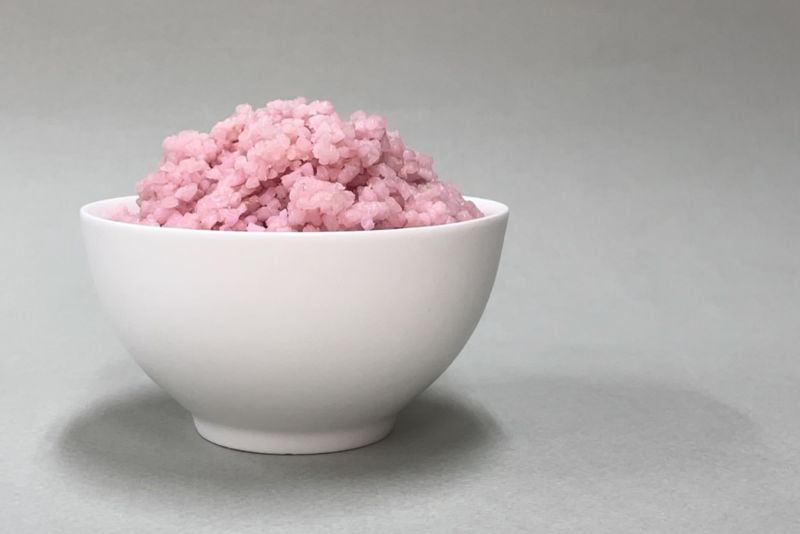Imagine eating a delicious, nourishing bowl of beef rice.
No, not beef on rice — beef rice.
That’s what a team of South Korean researchers are hoping to plate up with their newly developed hybrid rice, grown in a lab with cow muscle and fat cells inside the rice grains.
The rice — which is colored pink — could offer a cheaper, more environmentally sustainable source of protein with a much lower carbon footprint than beef, the researchers say.
“Imagine obtaining all the nutrients we need from cell-cultured protein rice,” primary author Sohyeon Park said in a news release on Wednesday, when the study was published in the journal Matter. “Rice already has a high nutrient level, but adding cells from livestock can further boost it.”
Here’s how they do it: They first coat the rice in fish gelatin to help the meat cells latch on better. Then, they insert cow muscle and fat stem cells into the rice grains, which are left to culture in a petri dish.
Animals have microscopic “biological scaffolds” that help cells grow to form tissue and organs, and rice grains have a porous, organized structure that mimic this scaffolding, as well as molecules that further nourish these cells, the study said.
The meat cells then grow on the surface of the rice grain and inside the grain itself. After about 9 to 11 days, you get the final product — which the study describes as “reminiscent of microbeef sushi and has a different texture, nutritional profile, and flavor than traditional rice grains.”
The beef rice is firmer and more brittle than the typically sticky, soft texture of regular rice — and is higher in protein and fat, the study found. Scientists steamed the rice to analyze it, finding that rice with higher muscle content smelled more like beef and almonds, while rice with higher fat content smelled like cream or coconut oil.
“A novel food ingredient that can overcome humanity’s food crisis has been created,” the study declared, adding that new solutions were critical in overcoming “rising health concerns, infectious disease risks, climate change, and resource scarcity.”
Meat alternatives and new food innovations have proliferated over the past few years, from plant-based options like Beyond Meat to lab-grown meat that all aim to reduce greenhouse gas emissions, particularly those generated by livestock.
Livestock systems are responsible for 6.2 billion metric tons of carbon dioxide entering the atmosphere each year. That’s around 12% of all human-caused emissions, UN data shows. Beef production is the most carbon intensive.
But many meat alternative products have struggled to break through to the mainstream market and appeal to consumers; after an extremely successful market debut in 2019, Beyond Meat lost favor with investors and saw its revenue plummet.
But the group of Korean researchers say their product may have an advantage; it uses safe, accessible and affordable ingredients, making the final product sustainable to produce and easy on the wallet, according to the study.
Lean beef currently costs about $14.88 per kilogram, and rice costs $2.20 per kilogram, whereas the beef rice, if commercialized, could cost just $2.23. And for every 100 grams of protein produced, the hybrid rice is estimated to release less than 6.27 kilograms (about 13.8 pounds) of carbon dioxide. The same amount of beef produces 49.89 kilograms (about 110 pounds) of carbon dioxide, the study said.
In theory, cows could one day be removed from the equation entirely. The researchers used cells taken from livestock for the study — but if they or other scientists can develop a cell line, meaning cells that can continue dividing and growing over long periods of time, “we can get our cells without livestock breeding,” said Park. “After that, we can create a sustainable food system.”
Neil Ward, an agri-food and climate specialist and professor at the University of East Anglia, who was not involved in the study, said the data looked “very positive,” with potential for helping develop “healthier and more climate-friendly diets in future.”
However, he said, “a critical test is around public appetite for these sorts of lab-developed foods.”
The beef rice won’t land in restaurants quite yet — the team plans to further develop the process so the cells can grow better in the rice grain and produce more nutritional value. They also hope this can improve the texture and taste of the rice, Park said. And as for its bright pink color? That comes from the cell culture medium that the rice is kept in, not from the meat cells, and it can be colored differently if another medium is used.
But Park has high hopes. One day, it might even be rolled out across supermarkets in ready-to-eat kits or meal packages, she said.
“Now I see a world of possibilities for this grain-based hybrid food. It could one day serve as food relief for famine, military ration, or even space food,” she said in the news release.






































